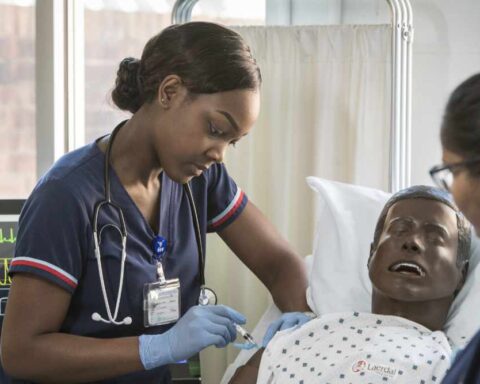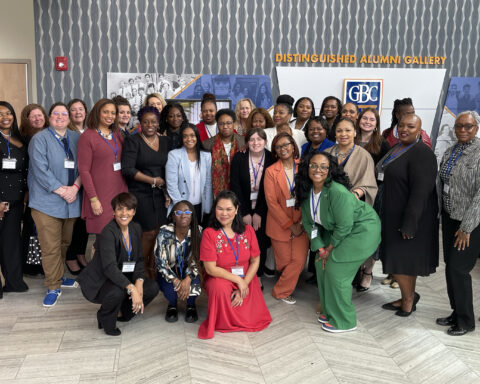By Dr. Donna Patterson
The USA Today network recently published the following op-ed by Dr. Donna Patterson, Chair of the Department of History, Political Science and Philosophy, on the importance of wearing masking during the ongoing COVID pandemic.
Like it or note, mask mandates help our war against COVID-19
Over the Thanksgiving holiday, Americans learned of a new COVID-19 variant, B.1.1.529 — Omicron. Early reports highlighted Omicron’s many mutations, and it was soon confirmed by research and medical record-keeping that Omicron spreads three to five times faster than the Delta variant. Given Omicron’s highly infectious nature, it was all but certain that it would spread rapidly across the globe.
Pandemics can be contained in a number of ways, including shutdowns and vaccines, but also with foundational public-health interventions such as masking, testing, and contact tracing. Mask use in particular is critical to reducing infections in the face of a respiratory illness than can be transmitted via the air. Widespread mask usage has largely been proven to be an effective deterrent against respiratory illnesses such as strains of influenza, SARS, and COVID-19 in countries that instituted widespread mask usage. COVID-19 numbers were already rising before the Omicron variant began spreading.
This week, Gov. John Carney, renewed the mask mandate in Delaware. This follows a recent state of emergency as Omicron cases rise in the state. In recent weeks, Delaware has faced compounding threats from record COVID-19 infections, overfilled hospitals and business closures. It is good to see Delaware make a bold step to try to begin curbing the state’s rising infections through indoor mask mandates. Even if some feel inconvenienced, masking is a less invasive way to protect our children and others in the community.
During a recent videoconference with governors, President Joe Biden said that states would lead the response to the Omicron surge: “[t]here is no federal solution. This gets solved at the state level.” As governors and other state officials in Delaware, Connecticut, New York, Louisiana and others make bold pandemic response policies, it is important that they get full federal support. Hopefully, other states will join some of these efforts to begin containing Omicron infections.
States, cities and towns across the nation are breaking their previous COVID-19 infection-rate records, surpassing the numbers recorded in 2020 and 2021. The average rate of daily rate of infection in the U.S. is more than 650,000 cases. Evaluation projects that without immediate and strong interventions, more than 3 billion of the globe’s inhabitants could be infected with COVID-19 in the next three months. While we hope that this scenario is unlikely, wishes alone will not prevent these projected numbers.
It will take more than more states join in using masking to begin to flatten Omicron infections. Delaware, Connecticut and a few other states can’t do this alone. If the U.S. can create coordinated messaging about masking, it would lead to greater buy-in from the American public. Consistent and widespread mask buy-in, with local, state, and federal support, would be a non-invasive and relatively accessible way to protect American citizens as the numbers of COVID-19 infections and hospitalizations surge. In Europe, many countries are also facing COVID-19 surges, but many are taking more concerted measures than the U.S. is taking to try and stem the spread. For example, the Netherlands has issued lockdowns and others nations are issuing curfews. Spain is requiring indoor and outdoor facemask use.
Starting with the Trump administration in 2020 and continuing through the early months of the Biden administration, there was widespread messaging in the U.S. about how masking could “flatten the curve.” Admittedly, not everyone, including some elected officials, followed these policies but mask use was fairly widespread in many states. States that bought-in to masking saw 70 to 80% mask buy-in reaped benefits in terms of fewer COVID-19 cases through spring 2021. However, after the Centers for Disease Controls and Prevention unexpectedly lifted the mask mandate in May, we’ve seen a steady rise in COVID-19 infections. Lifting the national mask mandate was premature, and it is time for the CDC to fully review this policy and communicate with the American public on the benefits of wearing facemasks. Vaccines and pharmaceuticals alone cannot stop a pandemic spurred by a respiratory illness.
Pandemic policy in the U.S. must move beyond centering solely biomedical interventions, such as vaccines and drugs coupled with economic incentives. To allow Americans to truly learn to live with COVID-19, U.S. policy needs to more deeply center public health measures such as affordable and widely accessible testing, facemask buy-in, and proper ventilation in schools, universities, offices and stores. In addition, social distancing will be vitally important over the course of the next two to three months.
These public health measures, if instituted immediately and used in tandem with other biomedical measures, will help to lower the incidence of COVID-19. To that end, the federal government must facilitate scaled production of tests and masks and help states and institutions such as schools, universities, and small businesses with renovations needed to provide ventilation that will protect students, staff, and employees. There is no single way to stop a pandemic, particularly one of this sort, and we need to use all of the tools at our disposal.







